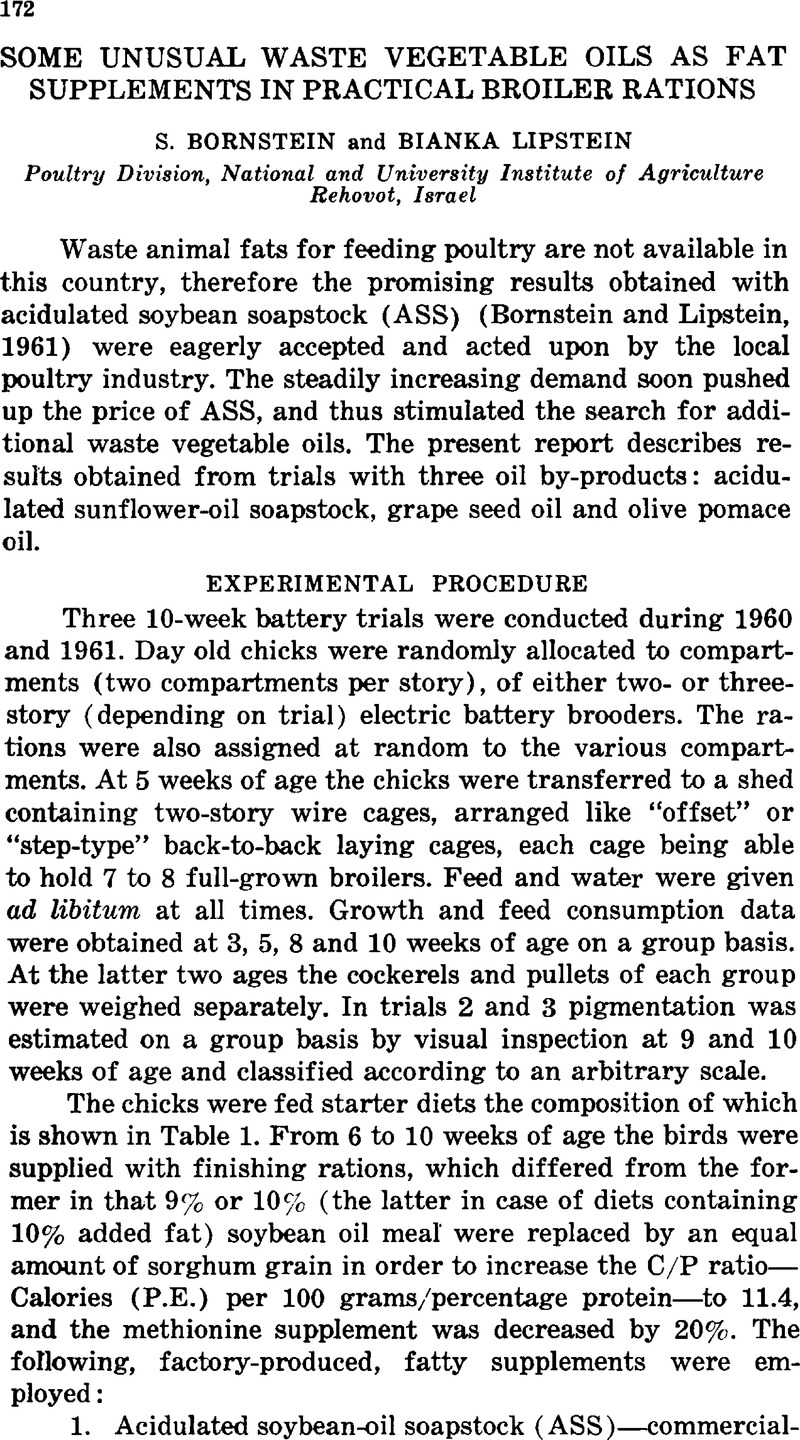Crossref Citations
This article has been cited by the following publications. This list is generated based on data provided by Crossref.
Bornstein, S.
and
Lipstein, Bianka
1964.
Methionine supplementation of practical broiler rations.
British Poultry Science,
Vol. 5,
Issue. 2,
p.
175.
Lipstein, Blanka
and
Bornstein, S.
1964.
Studies With Acidulated Cottonseed-Oil Soapstock.
Poultry Science,
Vol. 43,
Issue. 3,
p.
686.
Lipstein, Bianka
and
Bornstein, S.
1964.
Studies With Acidulated Cottonseed-Oil Soapstock.
Poultry Science,
Vol. 43,
Issue. 3,
p.
694.
Lipstein, Bianka
Budowski, P.
and
Bornstein, S.
1965.
Effect of Autoxidation on the Nutritive Value of Acidulated Soybean Soapstock in Chicks.
Poultry Science,
Vol. 44,
Issue. 6,
p.
1480.
Bornstein, S.
Lipstein, Bianka
and
Alumot, Eugenia
1965.
The Metabolizable and Productive Energy of Carobs for the Growing Chick.
Poultry Science,
Vol. 44,
Issue. 2,
p.
519.
Bornstein, S.
and
Lipstein, Bianka
1966.
Methionine supplementation of practical broiler rations.
British Poultry Science,
Vol. 7,
Issue. 4,
p.
273.
Lipstein, Bianka
Bornstein, S.
and
Budowski, P.
1967.
By-Products of the Refining of Soybean Oil as Pigment Sources for Poultry.
Poultry Science,
Vol. 46,
Issue. 3,
p.
626.
Bornstein, S.
and
Bartov, I.
1967.
Comparisons of sorghum grain (milo) and maize as the principal cereal grain source in poultry rations.
British Poultry Science,
Vol. 8,
Issue. 3,
p.
223.
1968.
Abstracts of Communications.
Proceedings of the Nutrition Society,
Vol. 27,
Issue. 2,
p.
51A.
Vermeersch, G.
and
Vanschoubroek, F.
1968.
The quantification of the effect of increasing levels of various fats on body weight gain, efficiency of food conversion and food intake of growing chicks.
British Poultry Science,
Vol. 9,
Issue. 1,
p.
13.
Bornstein, S.
Lipstein, Bianka
and
Bartov, I.
1968.
Comparisons of sorghum grain (Milo) and maize as the principal cereal grain source in poultry rations.
British Poultry Science,
Vol. 9,
Issue. 4,
p.
329.
Bornstein, S.
1970.
The lysine requirement of broilers during their finishing period1.
British Poultry Science,
Vol. 11,
Issue. 2,
p.
197.
Bartov, I.
Budowski, P.
and
Bornstein, S.
1970.
Anticholesterolic Effects of Unsaponifiable Fractions of Vegetable Oils in Chicks.
Poultry Science,
Vol. 49,
Issue. 6,
p.
1501.
Lipstein, Bianka
Budowski, P.
and
Bornstein, S.
1970.
By-Products of the Refining of Soybean Oil as Pigment Sources for Poultry.
Poultry Science,
Vol. 49,
Issue. 2,
p.
449.
GARDINER, E. E.
1970.
COMPARISON OF ACIDULATED RAPESEED-OIL SOAPSTOCK WITH ANIMAL TALLOW AS A SOURCE OF ENERGY IN BROILER DIETS.
Canadian Journal of Animal Science,
Vol. 50,
Issue. 3,
p.
529.
Lipstein, Bianka
Bornstein, S.
and
Budowski, P.
1970.
Studies with Acidulated Cottonseed-Oil Soapstock.
Poultry Science,
Vol. 49,
Issue. 6,
p.
1631.
Bornstein, S.
and
Lipstein, Bianka
1971.
Comparisons of sorghum grain (milo) and maize as the principal cereal grain source in poultry rations.
British Poultry Science,
Vol. 12,
Issue. 1,
p.
1.
Waldroup, P.W.
and
Tollett, V.E.
1972.
The Acceptability of Acidulated Cottonseed Soapstock as an Energy Supplement for Broiler Diets.
Poultry Science,
Vol. 51,
Issue. 6,
p.
1907.
Lipstein, Bianka
and
Bornstein, S.
1973.
The effect of dietary fish oil soapstock on the performance, carcass fat and flavour of broilers1.
British Poultry Science,
Vol. 14,
Issue. 3,
p.
279.
Bartov, I.
Lipstein, Bianka
and
Bornstein, S.
1974.
Differential Effects of Dietary Acidulated Soybean Oil Soapstock, Cottonseed Oil Soapstock and Tallow on Broiler Carcass Fat Characteristics.
Poultry Science,
Vol. 53,
Issue. 1,
p.
115.



